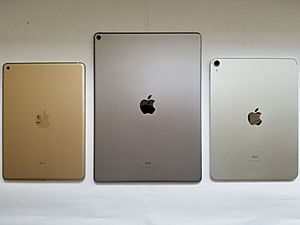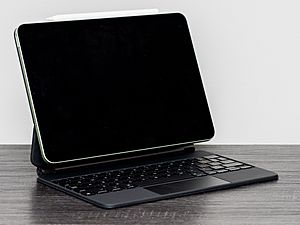IPad facts for kids

iPad Pro (6th generation)
|
|
| Developer | Apple Inc. |
|---|---|
| Manufacturer |
|
| Type | Tablet computer |
| Release date | April 3, 2010 (1st generation) |
| Units sold | 677.7 million as of 2022[update] |
| Operating system | iOS (2010–2019) iPadOS (2019–present) |
| Connectivity | WiFi, cellular, 30-pin dock connector, Lightning connector, USB-C, 3.5mm headphone jack, 3-pin "Smart connector" |
| Online services |
|
| Related articles | iPhone, iPod Touch (comparison) |
The iPad is a cool tablet computer made by a company called Apple Inc.. Apple first showed it to the world on January 27, 2010. It's bigger than a smartphone but smaller than a laptop computer.
The iPad has a special screen that you control by touching it with two or more fingers. This is called a "multi-touch" screen. Unlike a laptop, it doesn't have a built-in keyboard. Instead, it uses a "virtual keyboard" on the touch screen. You can also add a physical keyboard if you want!
Contents
The iPad's History
Apple made an early tablet computer way back in 1993. It was called the Newton MessagePad. It could do some things like the iPhone, iPod Touch, and iPad. But it didn't have advanced features like the internet. Apple stopped making Newtons in 1998.
Apple got back into making mobile devices in 2007. That's when the first iPhone came out. Some of the iPhone's ideas came from the old Newton.
By the end of 2009, people had been hearing rumors about the iPad for years. Then, on January 27, 2010, Steve Jobs, who was in charge of Apple, officially announced the iPad. It wasn't the very first tablet ever sold. But it was the first one that sold a huge number of units. It was also special because you could control it almost completely by touching the screen with your fingers. Many older tablets used lots of buttons or a stylus (a special pen for screens) to control them.
The first iPad went on sale in the United States in April 2010. It then became available in most other parts of the world within a few months.
Newer iPad Models
Apple announced the iPad 2 on March 2, 2011. It was released just nine days later, on March 11, 2011. This new iPad had a sleeker, thinner design. It also had curved edges, which was a change because people said the first iPad made their hands sore. The iPad 2 also added front and back cameras for photos and videos.
On March 16, 2012, Apple released the iPad 3. It looked like the iPad 2 but was a bit thicker. The iPad 3 was the first iPad to have a "retina screen." This means the screen was super clear, with so many tiny pixels that your eye couldn't see where they ended. It had 50% more pixels than a standard HDTV screen!
On November 2, 2012, Apple released the iPad 4. This model had a faster A6 processor. It also introduced a new charging port called "Lightning." This new port replaced the older, larger 30-pin connector. The iPad 4 also had an improved FaceTime camera. At the same time, Apple released a new, smaller iPad called the iPad Mini. It had a 7.9-inch screen instead of the usual 9.7-inch screen. However, the first iPad Mini did not have a retina display.
On October 22, 2013, the new iPad Air was announced. It looked like the iPad Mini but still had a full-size screen. It also had the newer A7 processor, which was also in the iPhone 5s. At the same time, a new version of the iPad mini was announced. This one finally had a super clear retina display.
On October 16, 2014, the iPad Air 2 was announced along with the iPad Mini 3. The iPad Air 2 was even thinner than the iPad Air. It had new features like a better camera and Touch ID. Touch ID is a fingerprint reader that lets you unlock your iPad with your finger. The iPad Mini 3 had the same design as the iPad Mini 2. But it also got a better camera and the Touch ID fingerprint reader.
On September 9, 2015, Apple announced a new, more powerful iPad called the iPad Pro. It came with either a large 12.9-inch screen or a 9.7-inch screen. It had a powerful A9X processor. Apple also made special accessories for it. These included a hardware keyboard that plugged into its side. There was also a stylus pen called the Apple Pencil. You could use the Apple Pencil to draw on the screen just like you would on paper.
On October 30, 2018, Apple updated their iPad Pro line. These new models were the thinnest iPads ever, at only 5.7mm thick. They had an improved A12x processor and a larger screen. They also added Face ID support, which lets you unlock the iPad with your face. The screen used Apple's new "liquid LED" technology, first seen in the 2018 iPhone XR. The new iPad Pro also came with cool accessories. These included a new Smart Keyboard, Apple Pencil, and different cases. Apple also changed the charging system from their old Lighting connector to a USB-C charger. The new iPad Pro models came in two sizes.
Apple keeps releasing new products every year. As of June 2023, the newest regular iPad is the 10th generation. It has a 10.9-inch screen and an A14 Bionic processor. The latest iPad Mini is the 6th generation, with an 8.3-inch screen and an A15 processor. The newest iPad Air is the 5th generation. It has a 10.9-inch screen and an M1 processor. The iPad Pro line has two current versions: the 6th generation with a 12.9-inch screen and an M2 processor, and the 4th generation with an 11-inch screen and an M2 processor. All older iPads are no longer sold by Apple.
In 2023, Apple also introduced two new apps for the iPad. Final Cut Pro helps you create videos and slideshows. Logic Pro is like a professional music studio for the iPad, letting you create audio.
All iPads, like most Apple products, are made in China. They are designed by Apple in California.
iPad Accessories
Apple offers many extra items, called accessories, for its iPad models. These include keyboards, styluses (pens for the screen), cases, and adapters. A 10-watt power adapter usually comes with the iPad.
Some cool Apple accessories include:
- The Apple Pencil: This is a wireless stylus pen that lets you draw and write on the screen.
- The Smart Cover: This is a magnetic screen protector that sticks to the front of the iPad. It has three folds so you can turn it into a stand.
- The Smart Case: This is a full case that protects both the screen and the back of the iPad.
- The Smart Keyboard Folio: This is an external keyboard that also acts as a case.
- The Magic Keyboard: This is another external keyboard. It's special because it has a built-in trackpad, which the other Smart Keyboards don't have.
iPad Software
When the iPad first came out in 2010, it used the same mobile operating system as the iPhone, called iOS. But in September 2019, Apple created a special version just for the iPad, called iPadOS. This new system is made to work even better with the iPad's larger screen and features.
The iPad can run almost every iPhone application. App developers can also make their apps work perfectly on the iPad's bigger screen.
The way you use the iPad's software is by touching the screen directly. You use "multi-touch gestures" like swiping, tapping, pinching (spreading two fingers apart), and reverse pinching (bringing two fingers together). The screen also has things you can control like sliders, switches, and buttons.
How People Use iPads
In Schools and Hospitals
The iPad is used in many ways in classrooms. It's a great tool for learning at home (homeschooling) and for learning from far away (distance education). Soon after the iPad was released, it was found that most of the popular book apps were for children. The iPad has also been called a helpful tool for children with autism. It can help them learn to communicate and socialize more easily.
In hospitals and healthcare, iPads and iPhones help manage supplies. For example, a company called Novation created an app called VHA PriceLynx. This app helps hospitals manage their buying processes more efficiently and save money. A person from Novation said, "Doctors won't walk around a hospital with a laptop. With an iPad it's perfect to walk around the hospital with as long as they have the information they need."
Fun Facts About the iPad
- In 2003, Steve Jobs told a reporter, "We have no plans to make a tablet."
- Apple actually started working on the iPad before they started working on the iPhone.
- The iPad was first planned to be a device mainly for reading books and newspapers.
- "iTablet" and "iSlate" were both thought of as possible names for the iPad.
- When they were developing the iPad, Apple tried adding a kickstand to hold it up.
- The very first iPad did not have a camera.
- Apple sold 300,000 iPads on its first day! They sold 1 million in less than a month.
- Apple releases new products often. The iPad 3 had the shortest sales life. The iPad 4 went on sale just 221 days after the iPad 3 was introduced.
- Steve Jobs did not give his own children an iPad. He said, "We limit how much technology our kids use at home."
- All Apple products have a secret codename. The iPod was "Dulcimer," the iPhone was "Purple," the Apple Watch was "Gizmo," and the iPad was "K48."
Related Pages
Images for kids
-
Steve Jobs announcing the first generation of iPad, 2010
See also
 In Spanish: IPad para niños
In Spanish: IPad para niños






